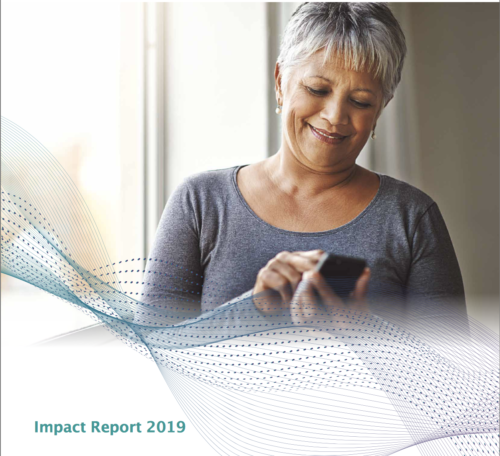The desperate need for digital innovation in urgent and emergency care – sparking connections and inspiring innovations
Written by Lesley Soden, Programme Director, Innovation Theme, Health Innovation Network

This winter has once again been a record-breaking one for A&E departments across the country —but not in a good way. Programme Director of Innovation, Lesley Soden, reflects on how technology, and not targets, needs to be the centre of the discussion to really support health and care providers delivering urgent care.
According to data and analysis published in the Health Service Journal earlier this month, overall type-one performance in emergency and urgent care units—the turnaround time for treating the most critical patients in A&E—has fallen nearly 11 percentage points since December 2018, while some individual trusts have experienced a year-on-year slide of between 20 and 30 per cent.
But how can anyone be surprised when in London alone, A&Es saw over 25,000 more patients in December 2019 than they did in December 2018.[1] Service expectations and pressures grow higher, while clinical staff continue to be spread thinner.
But instead of joining in the discussion on whether the targets need to change, I want to talk to you about the impact that existing technology could have on the urgent and emergency care system. Last October, at Health Innovation Network (HIN), we partnered with the DigitalHealth.London Accelerator programme to host an Innovation Exchange event to debate exactly the question I believe is the most important to answer – how can technology help? At the event, we brought together key stakeholders from the urgent and emergency care sector in London and creators of some of the latest innovations tackling ever-growing issues with the wait times and overall efficiency The event sought to achieve two things; firstly, to share a deeper understanding of vital NHS needs with the health tech innovators, and secondly, to start the conversation about how digital innovations that are already transforming other areas of healthcare might be able to help.
An honest discussion
Determined not to present an idealistic view of transformation, we started the day discussing the complexities of digital innovation. There are 32 CCGs across London, each with different systems, providers, patient pathways and data flows. This lack of cohesion across the board can result in real challenges for the introduction of new innovations, particularly digital ones. For example, a product may fit into one hospital easily, but be incompatible with another. Similarly, a product may require or generate specific data that we don’t have a standard process for sharing across multiple settings. These challenges are best appreciated when you look at urgent and emergency care. It is here that speed and effectiveness can make the difference in highly pressurised life or death situations.
It was eye-opening to hear about the level of activity that the London Ambulance Service (LAS) experiences. LAS handle approximately 5,000 emergency calls every day in London and has approximately 6,000 staff, 65 per cent of them front line staff responding to emergencies. On average, the LAS responds to all Category 1 calls (the most serious of emergency calls) within 6 mins 28 seconds. In these often-chaotic situations, bandwidth, hardware and human factors such as the staff’s experience of the technology, are all integral to a successful A&E handover.
Where technology is already helping
Stuart Crichton, Chief Clinical Information Officer (CCIO) at the LAS, described one of the challenges they experienced when implementing the use of iPads. The issue lay with ensuring that paramedics remembered their most up-to-date passwords. As we all do on occasion, staff kept forgetting their login details or couldn’t access their most up-to-date credentials (a password reminder was sent to an email address they couldn’t easily access). To resolve this issue, LAS removed the need for usernames and passwords, opting instead for using fingerprint recognition, the same type of technology many people use day-to-day with smart phones and tablets. Stuart described this as an exciting breakthrough, and a simple solution the LAS believes will have a positive impact in crucial life and death situations.
Dr. Gabriel Jones, Consultant of Emergency Medicine at St George’s NHS Foundation Trust, described the lightbulb moment he had when looking around the waiting room one day and noticing that almost all the patients who were waiting were using their smart phones. In the UK, 78 per cent of adults now have a smartphone. Dr. Jones recognised this as an opportunity to try something new. They designed a digital solution and set up a pilot, known at the hospital as ED Check-in, that enables patients to input information to a secure mobile website via their smart phones while they wait. A doctor can then access that information instantly, and it follows the patients through their hospital journey, keeping clinicians informed at each stage. Sometimes, clinicians with an entrepreneurial nature can design the best solutions to challenges within their health services, which is why it’s so important that they’re included in conversations around digital innovation.
… to create positive change, it’s imperative that today’s innovators understand the complications as well so they can deliver the most appropriate digital solutions
At the event, we were lucky enough to have guest speaker Eileen Sutton, Head of Urgent and Emergency Care at the Healthy London Partnership (HLP) and London Regional Integrated Urgent Care (IUC) Lead at NHS England. Eileen is a District Nurse by background and has a range of experience across the IUC system. She identified the need to reduce the number of people turning up at A&E with conditions or illnesses that could be treated at home, by a community pharmacist or other care professionals, and the need to improve patient flow to reduce the time spent waiting to be treated upon arriving at A&E as some of the greatest challenges. We know that NHS expert staff are the only ones who really understand the high complexity and nuance of these situations, but in order to create positive change, it’s imperative that today’s innovators understand the complications as well so they can deliver the most appropriate digital solutions.
Working with the DigtialHealth.London Accelerator Programme, we were able to identify 11 companies that offer solutions to these two main challenges. We held a rigorous and open application process for innovators to attend this event, during which they had the opportunity to pitch their innovations to London NHS commissioners, trusts and other NHS expert staff.
The companies selected to present were:
- Kinseed Swiftcare
- Health Navigator
- Q Doctor
- Healthy.io
- MedCircuit
- eConsult
- Medicspot
- Horiba
- CEMBooks
- Infinity Health
- MediShout
To demonstrate the real-world application of the innovations, we created some fictional scenarios in which the innovators present could help to reduce A&E attendance and improve patient flow.
Scenario one: Reducing A&E attendance challenge
We discussed Ahmed, a frequent visitor to his A&E for a number of minor ailments that could be managed by a pharmacy or primary care. At his next visit, he is referred to the Health Navigator solution and assigned a Health Coach, with whom he speaks weekly. He now rarely visits A&E and has joined local classes.
And Claire, who is worried that she has a UTI. We offer her a virtual and confidential consultation via Q Doctor with a doctor at a local urgent care centre instead. The doctor refers her to the local pharmacy to use the Dip-IO test from Healthy.io, which tests positive and the pharmacist then prescribes antibiotics.
And then Bob who calls 111. He is re-directed to the MedicSpot station at his local pharmacy, where he is given a remote consultation with a virtual doctor, who takes his blood pressure checks for other vital signs.
All three patients are given the care they needed in a timely and effective manner, without the need for ambulance or a prolonged wait in A&E.
Scenario two: Improving patient flow and reducing waiting times challenge
For our next challenge, we talked about Mary, who has multiple complex co-morbidities and goes to her local A&E when she experiences tingling in her legs. In the reception area, there are tablets with the eConsult triage system. Mary checks in using a tablet, by answering a few brief clinical questions about her symptoms. The system automatically triages Mary by her clinical symptoms within five minutes of her arrival.
While Mary is in the waiting area, she also inputs her symptoms, medication and medical history into the MedCircuit app, which helps save the doctor time and uses Mary’s wait more efficiently.
Mary sees the A&E doctor, but the light isn’t working in one of the consultation rooms. She uses the MediShout app to report this logistical issue, which links to the estates helpdesk and reports it immediately. She receives a notification that it will be fixed in two hours.
The doctor runs a full blood count test using Horiba’s Microsemi CRP device, which gives test results in four minutes. Mary is transferred to the x-ray department using the Infinity ePortering system to request a porter, saving critical time for herself and the doctors.
The A&E department also uses CEMBooks, which allows the consultant managing Mary’s case to plan her care and predict the demand for inpatient beds if this is required.
Mary deteriorates rapidly and requires a transfer to a specialist hospital. During her transfer in the ambulance, the MediVue platform provides real-time data taken from her monitor and active correspondence between the transferring doctor and the receiving hospital.
When she arrives at the specialist hospital, staff are prepared to smoothly transfer her to the appropriate unit, having already been informed of her history and symptoms.
These may be fictional scenarios, but they represent just a fraction of the real-life attendances to emergency care that technology could be helping make safer, more efficient and a better experience for both staff and patients. And most significantly, whilst time and efficiency were intended benefits of the digital solutions presented at the event, the focus of our discussions were about patient outcomes and supporting staff to deliver. Maybe if we changed the focus from targets to technology nationally too, we’d get to a clearer solution more quickly.
About the author
Lesley Soden
Programme Director – Innovation Theme, Health Innovation Network
Lesley has led the HIN’s Innovation Exchange function since 2017. She has over 20 years’ experience in the NHS and public sector working in senior business/strategy and programme management roles. Her roles have included work with transformation, contracts and commercial, programme delivery, business development/ planning, bid writing and clinical service re-design, all delivered in collaboration with a variety of partnerships. She is interested in new ways of working and maximising technology to improve patient care.


